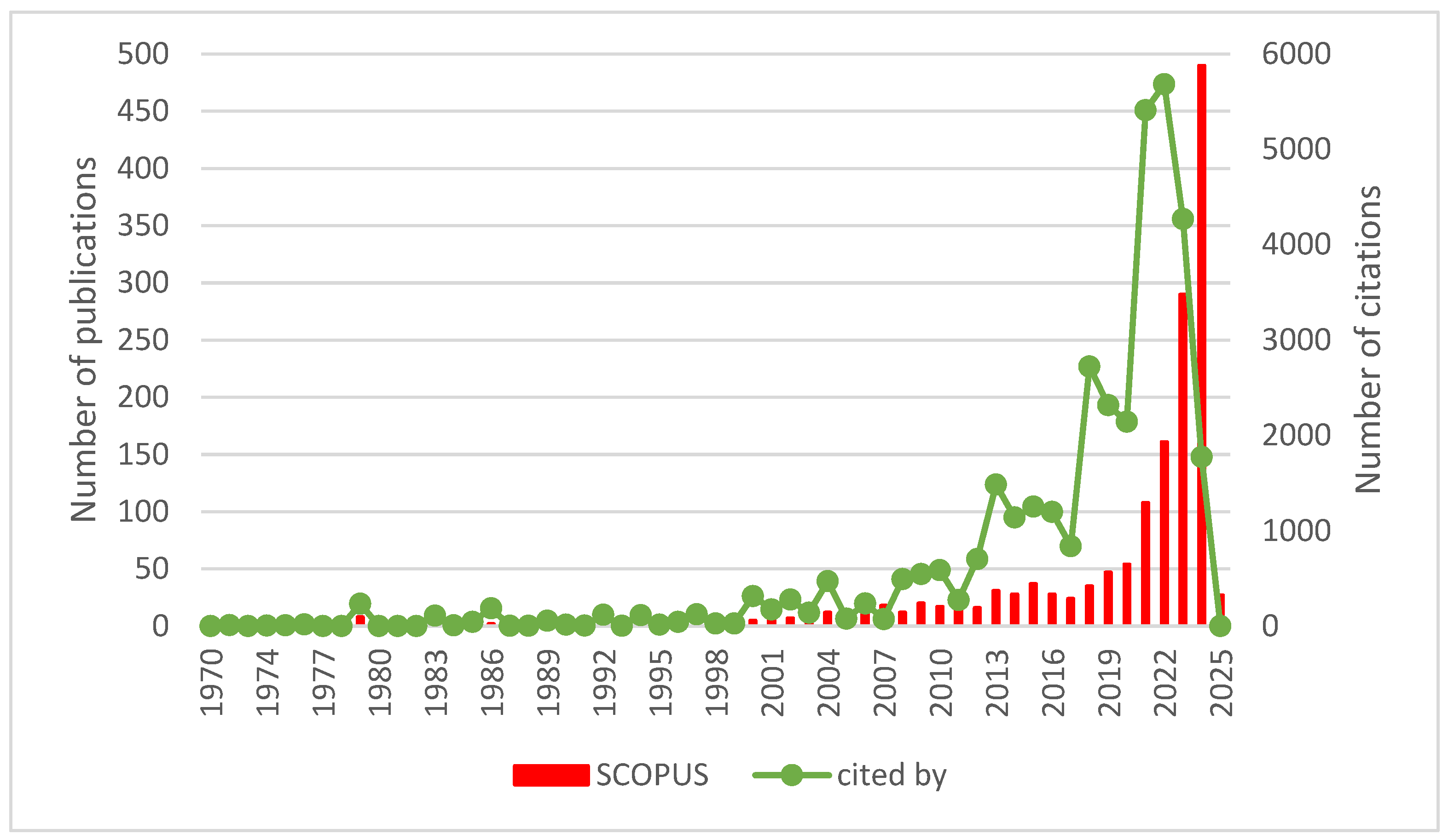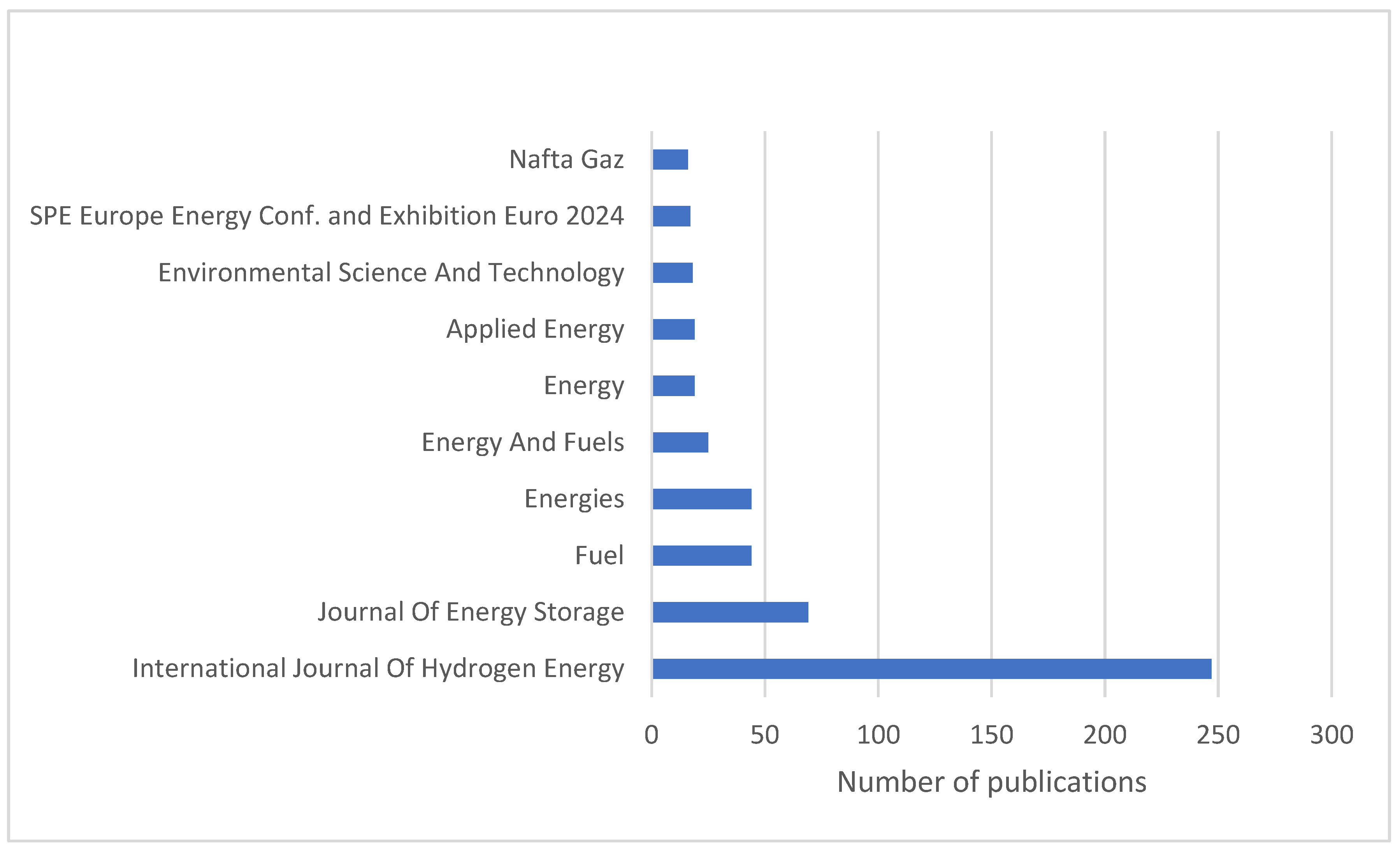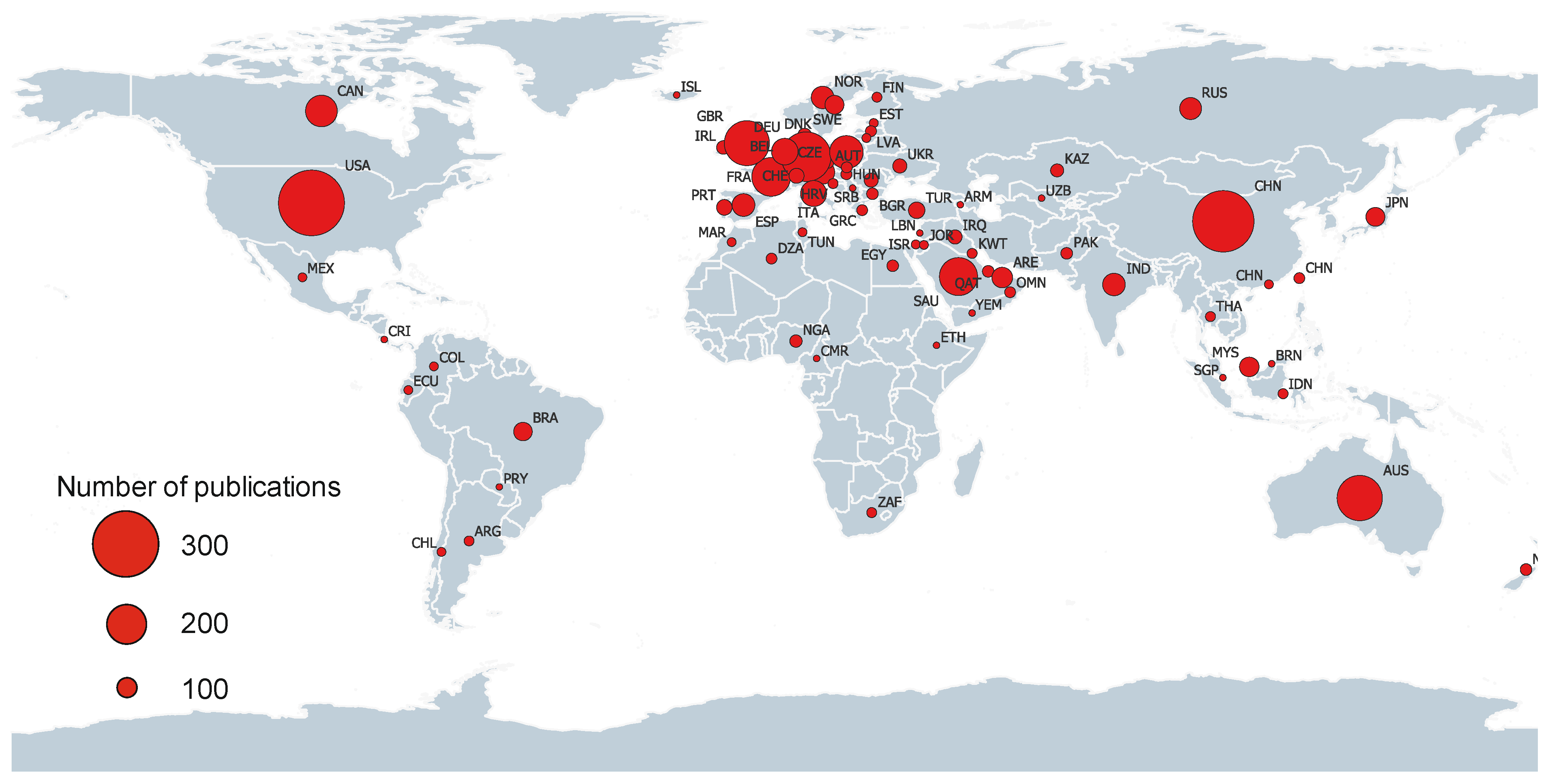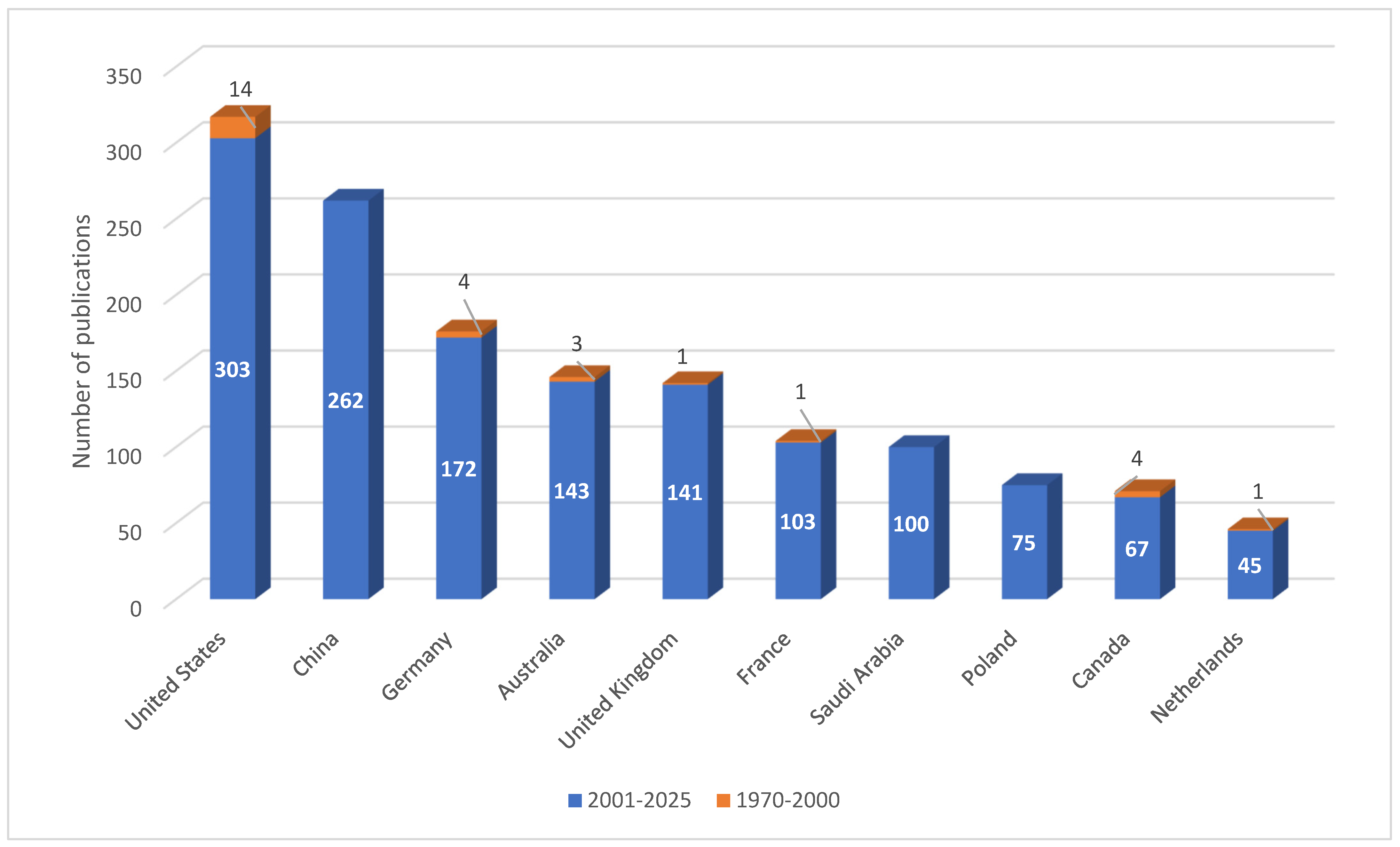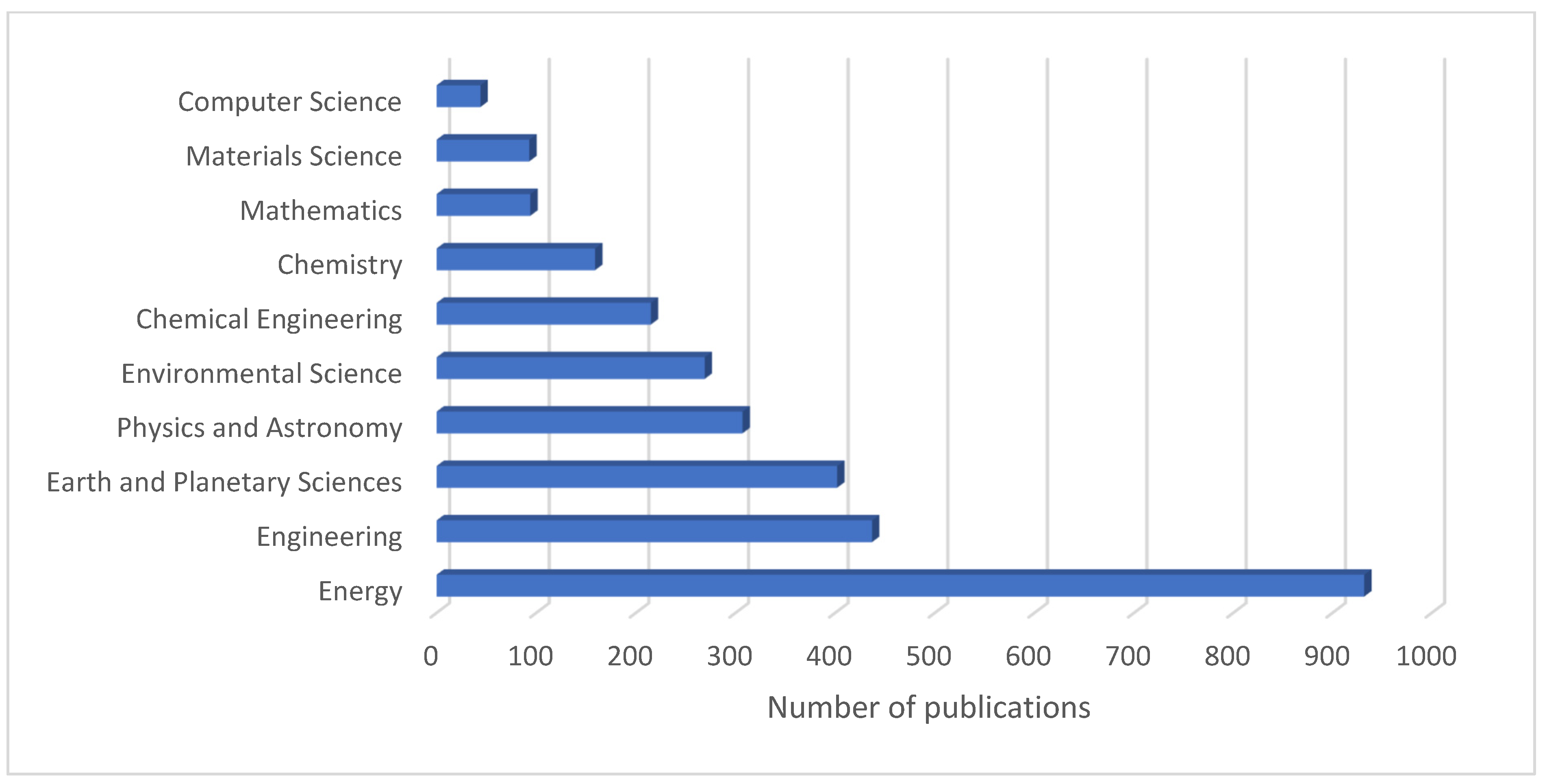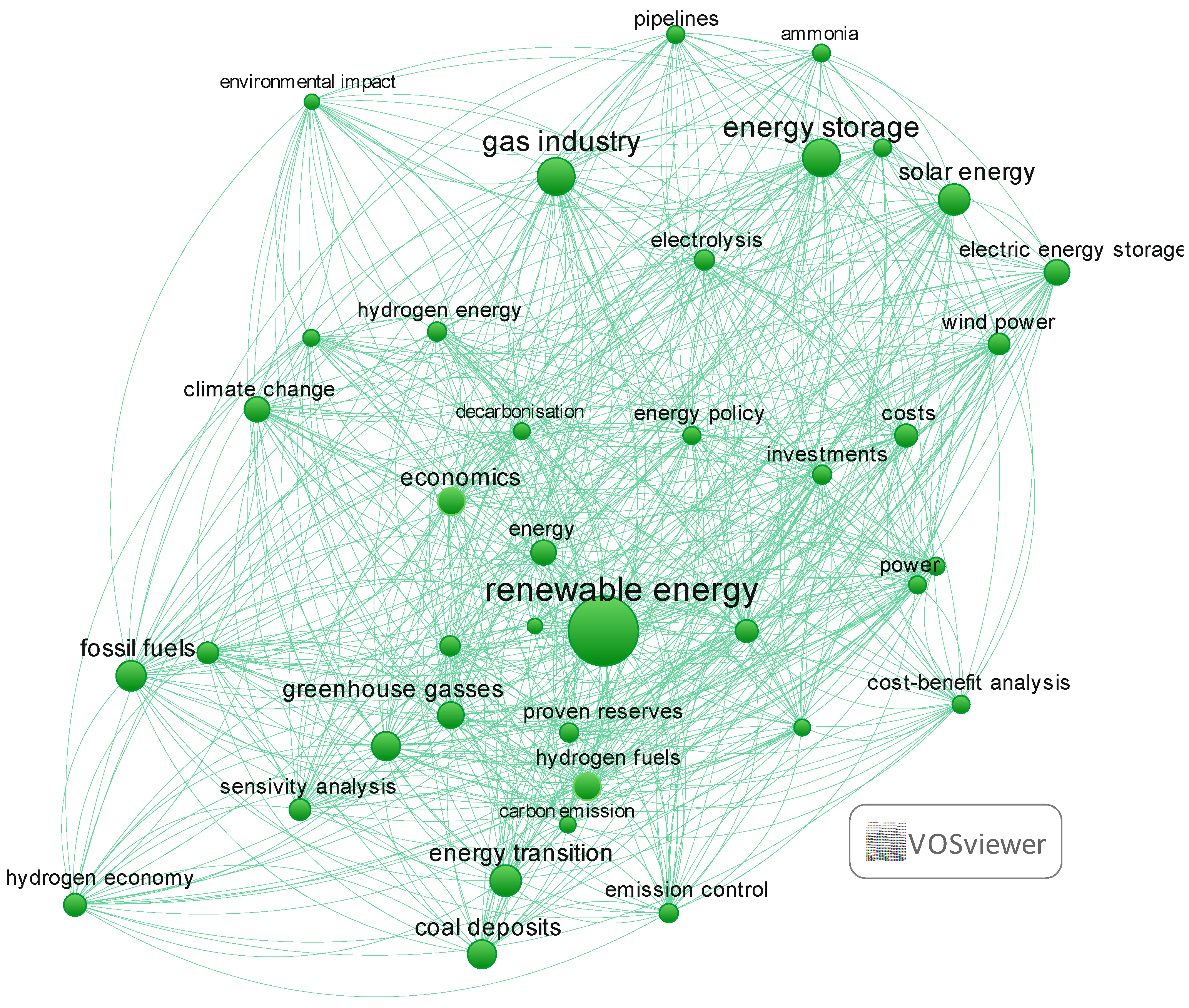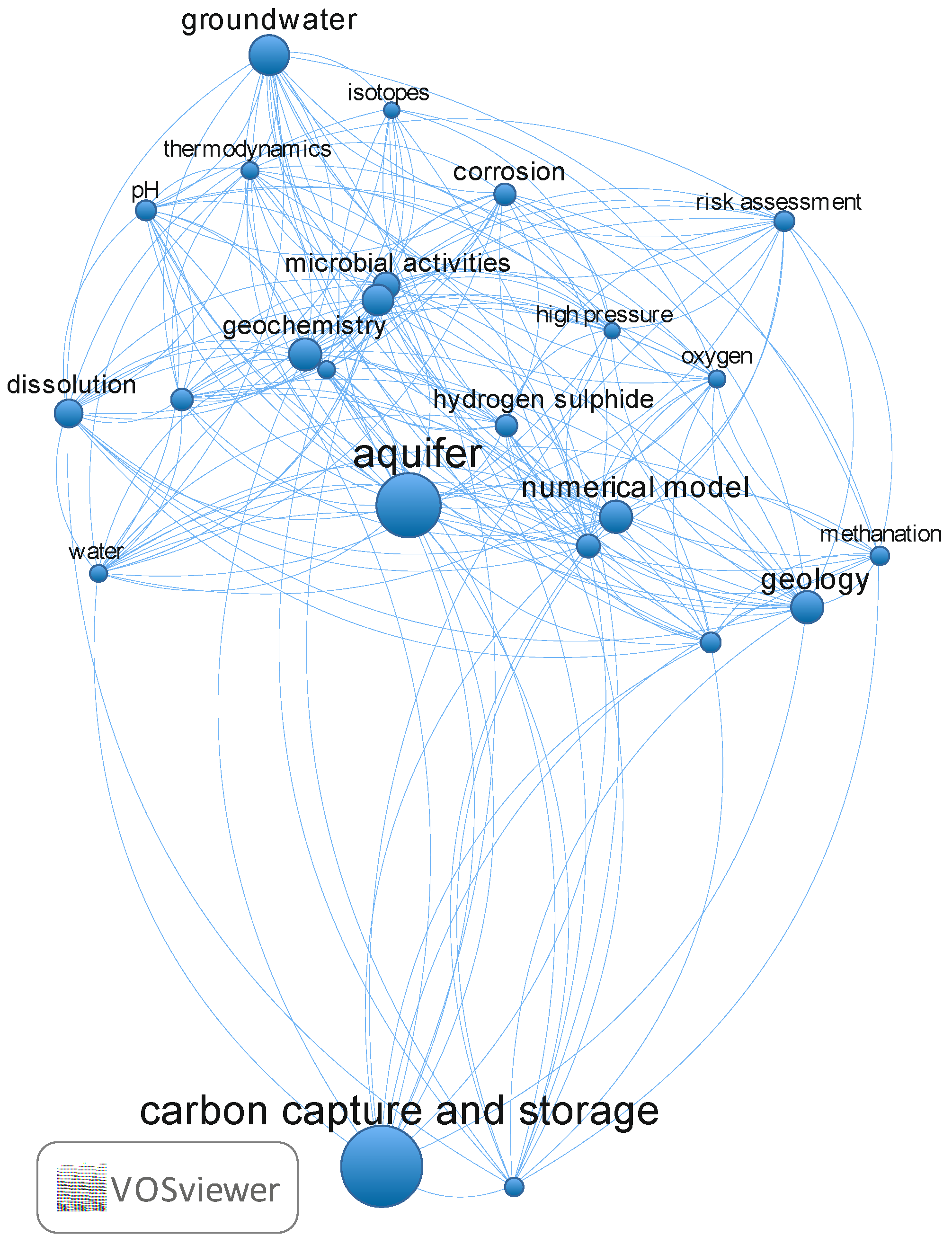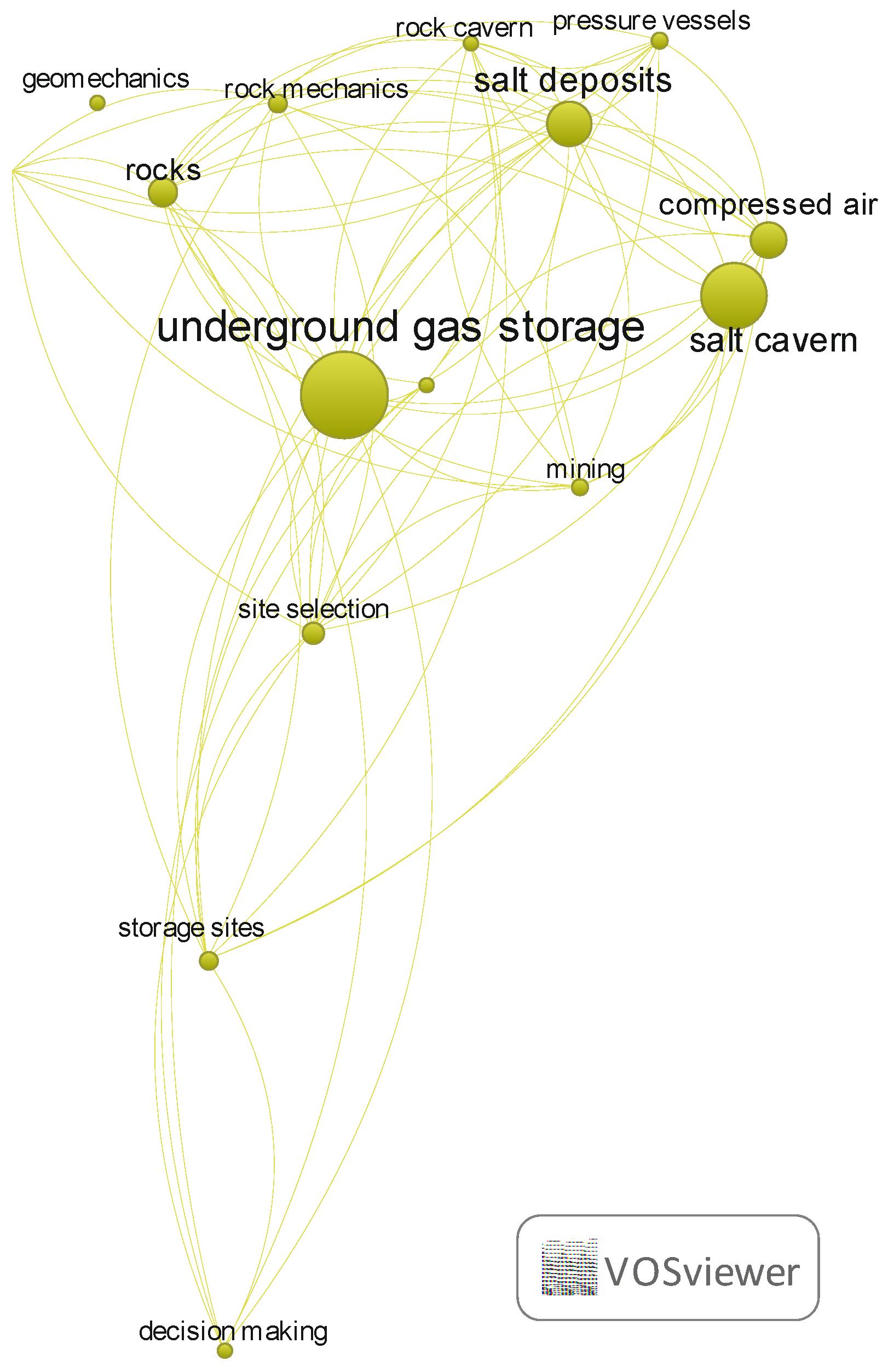1. Introduction
Underground hydrogen storage (UHS) has been in use since the 1970s. Its importance is growing as one of the components of future energy systems [
1]. The primary function of UHS is to store surplus renewable energy, thereby contributing to the stabilisation of power grids [
2,
3].
Hydrogen is regarded as a pivotal energy source for the future, owing to its high energy value, low emission profile of CO
2 during combustion, and its versatility in industrial, energy, and transportation applications. Nevertheless, the efficient utilisation of hydrogen requires the development of large-scale storage technologies. Conventional approaches, such as its storage in aboveground tanks under high pressure or in liquid form, are associated with substantial costs and technical risks and offer limited storage capacity [
1]. The storage of hydrogen in chemical materials, such as metal hydrides or liquid organic hydrogen carriers (LOHCs), is still in the research stage. Chemical storage enables the safe storage of hydrogen by binding it in stable chemical compounds [
4,
5].
Nevertheless, the key challenge of this technology is to optimise the hydrogen release processes and increase its energy density [
6].
The underground storage of hydrogen in geological formations, such as salt caverns or porous reservoir rocks, offers a significantly greater storage potential at a comparatively low cost in relation to other storage options [
7,
8,
9,
10,
11,
12]. Geological structures that have been identified as potential hydrogen storage sites include a variety of geological formations. Salt caverns, formed by the leaching of salt rocks, are characterised by high tightness and the potential for multiple gas storage cycles per year [
13,
14]. However, their main disadvantage is the limited availability of suitable salt deposits, as well as the cost and possible negative environmental impact associated with cavern leaching and brine disposal. In contrast, thick highly porous sedimentary rock formations have even greater storage capacity [
7]. These are widespread throughout the world but require careful geological assessment due to potential leakage risks and limited technological experience [
15,
16,
17]. Key aspects of underground hydrogen storage include safety, storage complex integrity, environmental impact, and economic efficiency [
7,
18,
19].
Underground hydrogen storage is one of the key technologies for the long-term storage of surplus energy, especially in the context of the growing role of renewable energy sources [
2,
3,
20]. Despite its conversion cycle exhibiting a lower efficiency in comparison to lithium-ion batteries, pumped-storage hydropower (PHS), and compressed air energy storage (CAES), only energy storage in chemical form as hydrogen is scalable [
10,
12,
18,
21,
22]. Notwithstanding, the challenges associated with UHS remain a point of concern, chief among them being the low efficiency of the overall cycle (electrolysis, storage, conversion) and the need to ensure the tightness of underground tanks and minimise the chemical reactions of hydrogen with the surrounding rock [
1,
2]. In the future, different energy storage technologies will complement each other—lithium-ion batteries will be suitable for short-term load changes, pumped-storage power plants for the medium term, and UHS for seasonal storage [
10,
22]. The choice of the optimal solution will depend on the local geological, economic, and energy conditions. Significant advancements in technology, research into hydrogen storage materials, and infrastructure development hold promise in enhancing the efficiency of UHS. This, in turn, is poised to be a key driver in the growing demand for clean hydrogen in industry and energy, thus underscoring the need for sustained investment in this technology.
The development and pilot testing of underground hydrogen storage are still in their early stages. In the context of the global energy transition and the growing need to decarbonise the economy, UHS is the subject of intense scientific and technological research. The implementation of full-scale commercial installations will take some time. Existing UHS projects are primarily oriented towards laboratory testing, modelling, and pilot storage facilities in Germany, the USA, and the UK. Safety concerns, challenges associated with hydrogen losses, and the cost effectiveness of storage in different geological formations have been identified as the primary obstacles to the implementation of this technology [
18,
23].
It should be emphasised that recent political developments have had an important impact on the global dynamics, the shaping of national energy strategies, and the direction of international co-operation in this field. Many governments are moving towards greater energy independence and decarbonisation and are changing their policies, with implications for financing and investment priorities. This context favours, among other things, the development of energy storage technologies and innovation in the green energy sector, but it can also create new challenges in terms of regulation and geopolitical competition. Technological progress is a key factor in the development of underground hydrogen storage research. Innovative solutions, such as advanced monitoring methods, computer simulations, and new materials, allow for the precise analysis of geological structures, facilitating the identification of optimal hydrogen storage sites, the increased safety of hydrogen storage operations through a better understanding of the mechanisms of hydrogen flow and reactions in underground structures, and improved economic efficiency. Recent developments in the international arena are creating a framework in which hydrogen storage technologies are being developed, and technological innovation is providing the basis for safe and efficient storage systems. This interdependence is essential to meeting the challenges of decarbonisation and ensuring global energy stability [
24,
25,
26,
27,
28].
Countries are considering the industrial and energy use of hydrogen and developing their own hydrogen strategies. The first national hydrogen strategy was adopted in Japan in 2017, followed by Australia and the Netherlands in 2019. Forty-six national strategies and eight hydrogen roadmaps were developed and published by May 2024. At least 20 more countries are in the process of developing such documents, making a total of 74 countries involved in clean hydrogen strategic planning. Ambitious hydrogen strategies that include the development of hydrogen technologies and underground hydrogen storage are being developed by the European Union, Poland, France, the USA, Germany, China, Japan, Australia, the UK, the Netherlands, and Canada. The EU and Poland plan to fund UHS projects directly. The USA plans to reduce the cost of hydrogen production. It offers tax breaks for the production of clean hydrogen. Germany has plans for a national hydrogen network and will be supporting projects through grants. China is developing hydrogen technologies and reducing hydrogen production costs to achieve carbon neutrality by 2060. Japan is investing in hydrogen valleys and green hydrogen production. At the state level, Australia is subsidising hydrogen projects. The UK is investing heavily in the development of hydrogen technologies. This technology is a key element of the energy transition. The Netherlands is focusing on integrating the energy system with hydrogen. Canada is spending billions of dollars to develop hydrogen production with the aim of achieving zero emissions by 2050 [
29].
Purpose and Scope of This Study
The purpose of this article is to present the latest research trends in the field of underground hydrogen storage, identified from a bibliometric analysis of scientific articles published in journals and materials indexed in the SCOPUS database.
Bibliometric analysis is an effective tool for identifying the main research directions, key scientific institutions, and the dynamics of the development of the selected scientific field. It has been employed in the analysis of issues related to the geological storage of CO
2 [
30,
31,
32], energy storage [
33], and hydrogen [
34]. Bibliometric analysis is an objective research method that utilises quantitative data, such as citations, to assess the influence of scholarly publications more accurately than a traditional literature review. Employing bibliometric tools such as VOSviewer enables the rapid processing of vast data sets to identify key research trends. A further key benefit is the ability of bibliographic analysis to facilitate the creation of network maps that provide a visual representation of the relationships between publications, authors, and institutions, thus enabling a more effective comprehension of the intricacies of the research structure. Moreover, the identification of thematic clusters and the monitoring of changes in research activity over time are further advantages of this approach. It is becoming increasingly used for analysing the quantitative literature [
35].
While there are existing analyses of various issues related to UHS, a quantitative approach to the problem of underground hydrogen storage in deep aquifers, depleted hydrocarbon reservoirs, and salt caverns has not yet been presented. Apart from a few articles using bibliometric analysis to present specific aspects of UHS, there is a paucity of review studies using this method for the whole range of UHS issues and all the main types of geological formations considered for underground hydrogen storage.
This article presents a novel approach to the analysis of bibliometric data. It focuses on the technological and environmental aspects of underground hydrogen storage, combined with an analysis of research trends and assessments of the development potential of UHS technology. The integration of these two aspects enables the identification of both areas of intensive research and promising future directions for scientific study. This comprehensive approach allowed for the identification of the dominant research topics.
The proposed bibliometric analysis enables a holistic approach to the research topic of UHS. It allows for the identification of links between UHS and other related fields, the identification of under-researched areas, and the forecasting of their development.
As part of the research work presented in this article, a systematic search of the SCOPUS database was conducted, covering publications related to underground hydrogen storage. The number of publications in the SCOPUS database, citation rates, authors, affiliations, countries, research areas, and keywords were taken into account.
This article is divided into several sections. The first part presents the methodology of the bibliometric research, including the criteria for selecting publications and the analytical tools used. The main part presents the results of the bibliometric analysis. The last part contains a discussion of the results of the bibliometric analysis and presents conclusions, recommendations, and perspectives for future research in this dynamically developing area.
2. Materials and Methods
The bibliometric analysis of publications related to underground hydrogen storage was conducted in four stages:
Stage 1 involved the analysis of the problem, which entailed the selection of a bibliographic database, the formulation of search phrases, the selection of search options, and the selection of an analysis period.
Stage 2 entailed the collection of data, the verification of the search results, the exporting of the results to appropriate formats, and the exporting of the final list to dedicated software.
Stage 3 entailed the actual bibliometric analysis, which involved the co-occurrence of keywords and cluster analysis.
Stage 4 entailed the analysis of research trends based on the articles indexed in the SCOPUS database.
For the initial stage of the publication search, the Web of Science and SCOPUS databases were selected as bibliographic databases. Web of Science (WoS) comprises a suite of databases administered by Clarivate Analytics. These databases contain records from a variety of subject areas [
36]. The SCOPUS database is created and managed by the publishing house Elsevier. SCOPUS provides access to the scientific literature in various fields, including the natural sciences, medicine, the technical sciences, the social sciences, and the humanities [
37]. Both databases are frequently employed in scientific research, in the evaluation of scientific output, and in the strategic planning of research development [
38].
In the preliminary search conducted in the Web of Science and Scopus databases, the phrase “underground hydrogen storage” was entered into the search engine. The search was performed for a time period of 1970–2025 and was carried out on 7 January 2025. Considering the significant changes in the number of publications on UHS in different time periods, as shown in
Figure 1, equal time intervals were chosen.
The search algorithm used was not constrained by any particular field or scientific discipline, allowing for a more open-ended approach.
The analysis included peer-reviewed articles published in scientific journals and those published in conference proceedings.
In the second stage, following a preliminary evaluation of the search results, the lists were exported to external Excel files for further analysis. This involved a comparison of the search results in the Web of Science and SCOPUS databases, which resulted in the selection of SCOPUS for further analysis.
The work conducted in the first and second stages enabled progression to the third stage, which is of crucial importance. In this stage, bibliometric analyses were carried out (citation counts, co-occurrence of words and clusters) [
39]. The scope of the studies conducted included the following:
Identification of publication trends related to the number of articles, citations, and most cited authors.
Identification of the countries, sources, and organisations that are of key importance to the area of study being analysed, based on the number of publications.
Identification of the most frequently cited publications.
Identification of the main subject areas of the publications related to the research area analysed over the period considered.
Identification of research sub-areas in the bibliometric data set based on an analysis of the most frequently occurring phraseological compounds.
In order to identify research trends, the subject area indicated for publications containing the phrase “underground hydrogen storage” was analysed for the periods 1976–2000 and 2001–2025, determined by the number of publications.
The bibliographic coupling method was used to identify research sub-areas. This approach facilitates the identification of the structure of the recent literature and the identification of potential future research questions. The analysis was carried out using VOSviewer, a tool designed to process and visualise bibliometric data, including the number of citations, frequency of words and terms, and content analysis. In addition, VOSviewer facilitates the grouping of related articles through the use of colour coding, as well as the construction and display of bibliometric maps [
40].
VOSviewer differs from other bibliometric software in that it is simple, intuitive, and freely available. Unlike expensive tools such as InCites and SciVal, VOSviewer is available to a wide range of users. Furthermore, compared to more advanced but more difficult-to-use tools such as CiteSpace and Gephi, VOSviewer offers easier-to-use features, making it an attractive choice for many researchers. As with any tool, VOSviewer has its limitations, including the quality and completeness of inputs, the subjectivity of parametrisation, and the limitations of visualisation [
41].
The analysis of research sub-areas was conducted on the basis of keywords from articles indexed in the SCOPUS database that also contained the term “underground hydrogen storage”. The co-word analysis method was employed, which involves the enumeration of the frequency with which word pairs occur in the analysed text. This technique facilitates the identification of phraseological relationships and regularities in the co-occurrence of words, which can indicate the existence of sub-areas of research or point to directions for further development of a given research area [
42].
The VOSviewer software 1.6.20 was used to identify clusters of groups of analysed terms. The cluster analysis was performed on the full group of items indexed in SCOPUS containing the keyword “underground hydrogen storage” used in the search. The purpose of conducting the cluster analysis was to identify the most frequently raised research issues. The analysis further identified emerging research themes that have come to dominate the field. The analysis of keywords, titles, and abstracts enabled the identification of changing directions and interests in the scientific literature in the analysed subject area. The identification of prevailing trends in the scientific literature facilitates the prediction of topics that are likely to become important in the coming years.
Citation analysis, one of the most established and widely used bibliometric methods, was also used to identify the most frequently addressed research subjects. This method examines the links between publications through citations [
43]. The main objectives of this method include the following [
44,
45,
46]:
Scientific impact assessment: the number of citations of a work can indicate its importance in a given field.
Identification of significant works and authors: through citation analysis, it is possible to identify publications that have played a major role in the development of a specific area of knowledge.
Examination of the relationship between publications and citation networks: this can help achieve a better understanding of how different studies are related to each other.
3. Results
3.1. Publication Trends
A comprehensive search of the Scopus database using the phrase “underground hydrogen storage” identified a total of 1601 records, as opposed to 1144 records from the Web of Science database (
Figure 1). The SCOPUS database contained articles that had been cited 35,785 times, with an average of 650 citations per year and 22.35 citations per article.
It is evident that interest in the subject of underground hydrogen storage has been increasing steadily since 1970, as reflected in the growing number of scientific publications on the topic. A significant increase in the number of publications was observed after 2000, which indicates the significant intensification of research in this area. From 1970 to 2000, a total of 82 publications were indexed in the SCOPUS database, whereas from 2001 to 2025, the figure increased to 1519 publications. The largest increase in the number of publications was observed in the last five years (2021–2025), when 67% of the publications on UHS indexed in SCOPUS were published.
A detailed analysis of the publications in the SCOPUS database reveals that 158 authors had five or more publications in the field of UHS, of which 33 published a minimum of ten articles. The ten most prolific authors in this field were then analysed based on the total number of articles, citations, and citations per year. The largest number of articles (44) on UHS was published by Stefan Iglauer (Edith Cowan University, Perth, Australia), followed by Ahmed Zarzor Al-Yaseri (King Fahd University of Petroleum and Minerals, Dhahran, Saudi Arabia) with 37 publications and Alireza R. Keshavarz (Edith Cowan University, Perth, Australia) with 36 publications. It is noteworthy that these authors appeared between 2021 and 2025. The high level of publication activity of these authors is reflected in their significant bibliometric indicators. Their H index was above 40, and the number of citations was above 4800.
3.2. Analysis of Major Countries, Sources, and Organisations
Of the 1601 scientific publications on UHS that were indexed in the SCOPUS database, 70% were articles in scientific journals, and 20% were papers and articles in conference proceedings. A significantly smaller number of publications appeared in trade journals (3%) and in the form of book compendia (4%) and book series (3%). It is noteworthy that the publications on UHS have appeared in a considerable number of sources. The total number of sources was 160, including scientific and professional journals, conference materials, and books and book series. The majority of these sources (140) published a maximum of 10 articles. Of the remainder, the largest number of scientific publications related to UHS topics appeared in the following journals:
The International Journal of Hydrogen Energy (21%),
Journal of Energy Storage (6%),
Fuel (4%), and
Energies (4%) (
Figure 2).
Between 1970 and 2025, research related to underground hydrogen storage was conducted in 79 countries. The level of involvement of researchers from each country varied. The majority of countries (66%) produced fewer than 10 publications, which may reflect the limited amount of UHS research conducted in these countries. Approximately 24% of countries produced between 10 and 100 publications. The remaining countries produced more than 100 publications. The geographical distribution of UHS-related publications was concentrated in six different regions and was dominated by the United States and the countries of the European Union, including the United Kingdom, with a total of 76% of publications (of which the United States accounted for about 20%) (
Figure 3). Among Asian countries, China (accounting for approximately 16% of the total number of publications) and Australia (about 10%) were also significant contributors.
The USA, China, Australia, Germany, the United Kingdom, Saudi Arabia, and Poland (
Figure 4) were the countries with the most intensive research collaboration on UHS, as measured by the number of joint publications. The strongest links in terms of collaboration were between the USA and China. In second place were the USA and Australia. Australia and China were in third place. Separate clusters group together countries that were linked by citations of the same publications. This means that countries in the same cluster may have similar research interests or scientific collaboration.
The level of interest in the subject of underground hydrogen storage in different countries has fluctuated significantly over time. During the period under analysis, the USA was the country with the highest number of publications (
Figure 5). The number of publications increased from 14 between 1970 and 2000 to 303 between 2001 and 2025. Concurrently, a substantial surge in publications was observed from China, rising from zero in the 1970–2000 period to 262 in the 2001–2025 span.
A total of 400 academic institutions and organisations have participated in research on underground hydrogen storage, 73 of which are organisations that have published more than 10 papers in this field. The institution with the highest number of publications was King Fahd University of Petroleum and Minerals (Saudi Arabia) with 64, followed by Edith Cowan University (UK) with 59 and Technische Universität Clausthal (Germany) with 53.
A total of 35,785 citations were recorded for articles indexed in the SCOPUS database and published between 1970 and 2025 on the subject of UHS. It is notable that more than 100 citations were recorded for 89 publications, while 19 publications received more than 200 citations (see
Table 1).
3.3. Research Trend Analysis
A thorough analysis of searches for the keyword “underground hydrogen storage” in the SCOPUS database was conducted over specific time frames ranging from 1970 to 2025. This analysis enabled the identification of the primary research areas within the field of scientific publications (
Figure 6). A total of 82% of the publications were allocated to the following areas: energy, engineering, earth and planetary sciences, physics and astronomy, environmental science, and chemical engineering.
The primary research topics in the field of UHS were as follows: energy (917), engineering (421), and earth and planetary sciences (392), which are related to environmental protection measures taken in various countries over the years. They focus on reducing greenhouse gas emissions through increased use of renewable energy sources (RESs).
The most frequently occurring keyword was hydrogen storage, which occurred 932 times. Other keywords with high frequency included hydrogen, underground hydrogen storage, underground gas storage, carbon dioxide, underground storage, aquifers, digital storage, caves, and hydrogeology (
Table 2).
Due to variations in keyword formulation by the authors of publications, the use of singular or plural forms (e.g., aquifer or aquifers), single words or phrases (e.g., petroleum reservoirs or hydrocarbon reservoir), and keywords with equivalent meanings, some keywords occurred several times. Consequently, the quantities in
Table 2 may not fully reflect the frequency of occurrence of some words in the keywords.
Synonyms such as carbon dioxide and CO2 were grouped together, as were keywords that are plural in the singular such as gas and gasses. In the analysis, the forms of the keywords that occurred most frequently in the articles were retained.
The substantial number of publications on various aspects of underground hydrogen storage enabled the observation of research trends over time. A review of publications on underground hydrogen storage in various geological formations, including aquifers, oil and gas deposits, and salt caverns, was conducted. An analysis of research trends was also undertaken, which revealed a notable increase in interest in this subject in recent years. In the case of aquifers, initial interest was low: only four publications appeared in the first period (1970–2000) and only one in the second (2001–2005). A subsequent rise was observed, with 13 publications in the third period (2006–2010), 20 in the fourth (2011–2015), and 30 in the fifth (2016–2020). However, the most significant surge occurred in the sixth period (2021–2025), with 276 publications.
A parallel trend was observed in the case of gas and oil deposits, with a similar increase in the number of publications. Initially, in the first and second periods, the number of publications was low, at three and four, respectively. However, an increase became noticeable in the third period (eight publications) and the fourth period (thirteen publications), which then accelerated significantly in the fifth period (66 publications) and the sixth period (287 publications). The most dynamic increase, however, was observed in the case of salt caverns. The initial interest was minimal, with only a single publication in the first period. In the subsequent periods, the number of publications remained at a similar level (four and three in the second and third periods, respectively), but in the fourth period, there was a substantial increase to 35 publications. The number of publications then increased to 50 in the fifth period and to the highest value among all categories (318 publications) in the sixth period.
In summary, all three categories have seen a sharp increase in interest recently, but salt caverns have become the most researched solution. Gas and oil deposits and aquifers have also gained popularity, although their growth has been somewhat less dynamic. The available data demonstrate that underground hydrogen storage is a topic that is the focus of an increasing number of research projects, with a particular interest in the possibility of its storage in salt caverns.
In order to identify research areas, data were extracted from the SCOPUS database and analysed using VOSviewer software. The keywords present within the publications were analysed and extracted using the phrase “underground hydrogen storage”. The analysis of the retrieved data identified four research areas (items) (
Figure 7). Each research area contained keywords whose frequency of occurrence is illustrated by the size of the sign, and the lines connecting them illustrate the bibliographic links occurring between each word.
The analysed clusters encompassed four distinct subject areas addressed in the analysed publications. The first cluster included 51 keywords, listed in
Table 3 in descending order of frequency of occurrence in the articles. These keywords relate to technical and reservoir aspects, with a particular focus on storage technologies in porous media (see
Table 3). The second cluster contained 39 keywords related to energy transition and sustainable development economics. The third cluster, which contained 24 keywords, relates to issues of underground carbon storage and underground storage processes. The final highlighted cluster, the least numerous of the five, contained 14 keywords and is concerned with the geological and reservoir aspects of gas storage in salt rocks.
4. Discussion
Bibliometric research methods have been proven to be an effective tool in the quantitative analysis of publications, thus facilitating a more comprehensive understanding of the dynamics of scientific activity in a specific research topic. These methods find application in numerous domains, ranging from the evaluation of individual researchers’ scientific contributions to the analysis of scientific institutions’ achievements, even extending to the shaping of scientific policy at both national and international levels. In the contemporary era, they have evolved into an indispensable instrument, facilitating the analysis and comprehension of research activities [
38,
62,
63].
Bibliometric analysis is an effective tool that can be used to search the content of scientific publication databases such as SCOPUS and Web of Science. attention n [
30,
31,
32,
64,
65,
66]. As demonstrated in the aforementioned articles, the results obtained provided interesting insights, facilitating the understanding of the research methodology and inference at both the general and specific levels.
This article also presents the results of a literature analysis in the field of UHS, with the employment of information visualisation technology serving to extract knowledge from the SCOPUS database and create domain maps. The bibliometric analysis conducted and the results obtained confirm its usefulness in the field of UHS, as an effective tool for identifying the main research directions, key scientific institutions, and the dynamics of development of the selected scientific field. The research methodology employed in the analysis encompassed four stages: problem analysis, data collection, bibliometric analysis, and research trend analysis. This methodological framework enabled the fulfilment of the fundamental purpose of this research, namely the presentation of the latest research trends in UHS. From a methodological perspective, the results indicate that certain keywords appeared in both singular and plural forms or were words with equivalent meanings. This study indicates that the choice of appropriate keywords in the analysis is a crucial element that impacts the findings.
A systematic search of the SCOPUS and Web of Science databases, as well as all UHS-related publications occurring in them, for the years 1975–2025, was conducted. This allowed for the conclusion that the phrase “underground hydrogen storage” occurred much more frequently in the SCOPUS database than in the Web of Science database. Consequently, the SCOPUS database was deemed to be superior and was selected for further detailed searches. The lists obtained from the SCOPUS database, exported to external Excel files, formed the basis for the actual bibliographic analysis. The bibliographic analysis was performed in accordance with the indications of Zupic and Čater (2015) [
39], which allowed for the identification of the following key subject areas of publications: countries of key importance to the analysed research area, the most frequently cited publications indexed in the SCOPUS database, and the research sub-areas.
The Scopus database adequately reflects the state of knowledge in individual fields, due to its wide coverage and rigorous selection procedures, covering publications from over 7000 publishers and 240 disciplines. However, its preference for English-language journals can lead to language bias. This affects the visibility and citation of scientific papers from other regions. The dominance of English can be a barrier for some authors and publishers, even though Scopus covers publications in more than 40 languages. In the data analysed, the share of publications in English was dominant at over 90%.
In order to identify the research sub-areas, the VOSviewer program [
40] and the co-word analysis method [
42] were utilised. These tools are commonly employed in this type of research. A co-word analysis was conducted to identify the links between publications through citations [
44,
45,
46].
A detailed discussion of the results and interpretation is provided below. The analysis carried out shows the chronological distribution of the research results, the geographical and institutional variability, and the varying participation of major publishing journals. The analysis indicates the emergence of novel research directions and the prospective frontiers of future research. A similar variation was noted by Wang et al. (2024) [
32] for publications in the field of CCS. In the case of the present analysis, the turn of the century marked a significant increase in the number of publications, from 82 in the 2000s to 1524 in the 2020s. A geographic analysis revealed that the United States and China are at the forefront of UHS research. It is notable that China has seen a considerable upsurge in publications, which commenced only after the year 2001. The following eight countries were identified as having the highest number of publications: Germany, Australia, the UK, France, Saudi Arabia, the Netherlands, Poland, and Canada. Excluding the EU countries, there was a notable development of UHS topics in Australia, Canada, and Saudi Arabia.
A search of the SCOPUS database using the phrase “underground hydrogen storage” yielded 35,785 citations between 1970 and 2025, with 19 publications cited more than 200 times. This finding suggests the presence of a group of researchers who are engaged in intensive research in the analysed topic and who have established robust research teams within their respective institutions. The vast majority of the publications analysed were articles in scientific journals, accounting for 70% of the total, while the remainder were papers, articles in conference proceedings, and others. With regard to the journals under scrutiny, the preponderance appeared in the International Journal of Hydrogen Energy (35%), Renewable and Sustainable Energy Reviews and Energy and Environmental Sciences (11% each), and Environmental Chemistry Letters and Chemosphere (6% each). It is noteworthy that these journals are widely regarded as the most prestigious in the field of UHS-related publications.
The research domains encompassed by the analysed publications were as follows: energy, engineering, earth and planetary sciences, physics and astronomy, environmental science, and chemical engineering. This finding suggests that the subject of underground hydrogen storage is interdisciplinary, thus indicating the high potential for collaboration among specialists from diverse fields. The following research themes were identified: energy, engineering, and earth and planetary science, with a core focus on endeavours to augment the utilisation of renewable energy resources.
The use of VOSviewer software to analyse the keywords extracted using the phrase “underground hydrogen storage” yielded four key research areas, which is one of the most significant results of the analysis conducted. The identified areas delineate a multidimensional picture of related research and include technological, geological and reservoir, environmental, and economic challenges. The visualisation of the keyword map referenced to “underground hydrogen storage” revealed numerous subfields and research pathways. The primary research clusters were as follows: hydrogen and hydrocarbon reservoir engineering (
Figure 8); hydrogen economy and energy transformation (
Figure 9); processes in hydrogen storage sites, including lessons from CO
2 sequestration (
Figure 10); and the geology, engineering, and geomechanics of underground gas storage (
Figure 11).
Cluster 1: Hydrogen and hydrocarbon reservoir engineering (see
Figure 8) includes research on the mechanisms of hydrogen flow and transport in porous media. This research involves the use of modelling, numerical simulations, and physical experiments to determine optimal hydrogen storage conditions. Modelling to predict hydrogen behaviour includes capillary pressure, changes in wettability, surface tension, and adsorption. Research into the influence of mineralogical and chemical properties on hydrogen storage focuses on the interaction of hydrogen with the reservoir and surrounding rock-forming minerals, wettability analysis, and hydrogen adsorption. The use of advanced imaging techniques, including X-ray microtomography and electron microscopy, facilitates detailed studies of pore structure. The evaluation of depleted oil and gas reservoirs as potential hydrogen storage sites involves the analysis of leakage, storage capacity, and hydrogen storage efficiency. Hydrogen storage efficiency studies focus on two aspects: minimising hydrogen losses and optimising buffer gas utilisation. The analysis includes studies of hydrogen solubility in water and chemical reactions affecting hydrogen storage. The impact of material and equipment selection on hydrogen storage focuses on analysing the durability of cements and well materials in contact with hydrogen to minimise chemical reactions leading to a loss of integrity. The interdisciplinary nature of these research trends is reflected in the different scientific disciplines involved, including fluid mechanics, geology, materials engineering, and chemistry.
Cluster 2: The subject of hydrogen economy and energy transformation (see
Figure 9) encompasses issues of energy transition and decarbonisation, with research incorporating the integration of hydrogen technologies into current fossil fuel-based systems. The reduction in emissions in the gas and coal industries can be achieved through the utilisation of hydrogen, with the development of energy production and storage technologies centred on efficient electrolysis technologies for green hydrogen production. The integration of hydrogen with renewable energy systems involves the use of surplus energy from RES to produce hydrogen as a flexible energy carrier. The economics and efficiency of hydrogen systems include cost–benefit analyses for hydrogen technologies and the optimisation of hydrogen production and distribution systems. The focus of sustainable development is on energy policy research supporting the development of the hydrogen economy and the reduction in carbon emissions. The utilisation of hydrogen as an energy carrier in the transport sector will necessitate the future integration of fuel cells with various types of transport and the development of a hydrogen transmission infrastructure. The optimisation of energy systems focuses on the energy efficiency of hydrogen systems and their interaction with other technologies. Ammonia is being studied as an alternative hydrogen carrier due to its ease of transportation and storage. Research on the impact of hydrogen on energy infrastructure also concerns the adaptation of natural gas transmission systems to hydrogen transmission.
Cluster 3: Processes in hydrogen storage sites, including lessons from CO
2 sequestration (see
Figure 10). The recognition of chemical and biological processes occurring in underground H
2 storage sites takes into account studies of dissolution and chemical reactions during the sequestration of CO
2 and other gasses. Microbial processes, such as methanogenesis, play a significant role and can affect the stability and efficiency of storage processes. Methanogenesis can potentially affect the chemical and physical properties of the reservoir. Furthermore, studies on the interactions between CO
2, hydrogen, and sulphur compounds help to explain their impact on the chemical properties of rocks and fluids in the context of hydrogen storage. In the context of reservoir integrity, studies on the impact of geochemical interactions are imperative. This involves the analysis of temperature, pH, and pressure, the impact on corrosion processes, as well as changes in water chemistry and rock chemistry. The risk assessment should take into account long-term geochemical changes occurring at the storage site and their impact on the integrity of geological formations. Numerical simulations of geochemical processes and multiphase flows allow for the creation of models of H
2 behaviour using CO
2 sequestration experience. These models are used to predict the performance of the storage process and its impact on the environment, especially groundwater. In addition, chemical and mechanical interactions occurring during gas injection are of particular importance. These interactions encompass the impact of acid gas injection (e.g., H
2S) on wellbore integrity and equipment corrosion.
Cluster 4: Geology, engineering, and geomechanics of underground gas storage (see
Figure 11). This cluster centres on the selection of underground gas storage locations and on the geological, technical, and environmental aspects involved. The gas storage potential of salt caverns is being studied for their low permeability and high tightness, salt leaching processes, and long-term stability of the rock under high pressure. Conversely, the field of rock mechanics and geomechanics centres on the mechanical properties of rocks to assess their resistance to deformation and damage under gas pressure, including gas–rock interactions and modelling of rock behaviour over the long term. The fourth cluster also presents compressed air storage (CAES) technology in underground caverns as an alternative to traditional energy storage methods. The long-term stability and safety of gas storage caverns is analysed in the context of operating pressures, natural geological processes, and potential failures, which is crucial for assessing the risk of gas leaks and their impact on the environment. Research on adapting existing underground structures, such as natural caverns, for the storage of gasses such as hydrogen, analyses potential changes in the mechanical and chemical properties of these structures. Decision-making processes play a key role in the selection of storage sites, risk assessment, and environmental management.
Gaps in the monitoring and risk assessment of underground hydrogen storage include the lack of regulatory requirements and the lack of good practise in the selection of UHS monitoring techniques. Inadequately researched issues include the monitoring of underground storage in aquifers, the influence of coupled hydrodynamic, bio- and geochemical effects on hydrogen uptake and purity, and the development of more advanced monitoring technologies that can accurately track changes in underground hydrogen storage.
5. Conclusions
The bibliometric analysis enabled the identification of scientific articles on UHS that were published in journals and materials indexed in the SCOPUS and Web of Science databases. The analysis enabled the identification of research areas characterised by intensive activity, the identification of promising directions for future development, the identification of key research centres, and the dynamics of the development of UHS research topics. This study revealed the chronological dispersion of the research results, their geographical and institutional variability, and the varying contributions of major publishing journals.
The analysis conducted, which included the analysis of the problem, data collection, proper bibliometric analysis, and analysis of research trends based on the most cited articles, provided methodological insights. The primary phrase analysed, “underground hydrogen storage”, covering publications from 1976 to 2024, demonstrated that the selection of appropriate keywords for analysis is a crucial element influencing the results obtained. The research methodology presented can serve as a foundation for future research by other scientists, particularly in the analysis of their own research topics.
The implementation of VOSviewer software enabled a comprehensive analysis of the keywords, facilitating the identification of four key research areas and numerous related, albeit less significant, research trajectories. The following topics were included in these areas: hydrogen and hydrocarbon reservoir engineering; hydrogen management and energy transition; processes in hydrogen storage, including lessons from CO2 sequestration; and the geology, engineering, and geomechanics of underground gas storage. The analysis thus provides a comprehensive overview of the interdisciplinary nature of UHS research, emphasising the synergies between related fields such as geology, reservoir engineering, chemical engineering, energy, economics, and others.
The analysis demonstrated that the development of underground hydrogen storage is informed by the experience gained in the storage of other gasses, including methane and carbon dioxide, the latter in the context of CCS and CCUS. While these technologies bear many similarities, significant differences arise due to the unique characteristics of hydrogen. A lack of publications and the literature on certain key issues exists, such as monitoring underground hydrogen storage, the risks associated with UHS, and the environmental impact of this technology.
